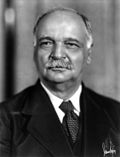Top Qs
Timeline
Chat
Perspective
1932 Republican National Convention
American political convention From Wikipedia, the free encyclopedia
Remove ads
The 1932 Republican National Convention was held at Chicago Stadium in Chicago, Illinois, from June 14 to June 16, 1932. It nominated President Herbert Hoover and Vice President Charles Curtis for reelection.[1]
This article relies largely or entirely on a single source. (November 2011) |
Hoover was virtually unopposed for the nomination. Despite the economic crisis facing the country, the convention praised Hoover and pledged itself to maintain a balanced budget.
Remove ads
Presidential nomination
Summarize
Perspective
Presidential candidates

Republicans gloomily gathered in Chicago for the 20th Republican National Convention. Los Angeles attorney Joseph Scott delivered President Hoover's nominating address, praising him as the man who taught the nation to resist the temptations of governmental paternalism. Hoover was re-nominated on the first ballot without significant opposition. To have repudiated the incumbent would have destroyed what little chance of victory the party had amid the worst economic depression in U.S. history.
Former Senator Joseph I. France of Maryland attempted to engineer a "draft Coolidge" movement, but the former president expressed no interest in the nomination.
Presidential Balloting / 3rd Day of Convention (June 16, 1932)
- 1st Presidential Ballot
Remove ads
Vice Presidential nomination
Summarize
Perspective
Vice Presidential candidates
Vice President Curtis experienced more difficulties than President Hoover in securing his party's re-nomination. It took the fervid appeals of Hoover's cabinet members to keep the Illinois delegation from nominating former Vice President Charles Dawes for his old office. Curtis nonetheless still had to fight for his re-nomination despite the disorganization of his opposition by the advance refusal of Dawes to accept the nomination for second place. Ambassador Hanford MacNider and RCA Chairman James Harbord, both military professionals, were the primary beneficiaries of the opposition to Curtis.[2]
The initial roll call revealed Curtis to be 18 votes shy of securing re-nomination. At this point, Pennsylvania switched its 75 votes from favorite son Edward Martin to Curtis. After Curtis had secured the vice presidential nomination, the delegates moved to make his re-nomination unanimous.[2]
Vice Presidential Balloting / 3rd Day of Convention (June 16, 1932)
- 1st
Vice Presidential Ballot
(Before Shifts) - 1st
Vice Presidential Ballot
(After Shifts)
Remove ads
See also
References
External links
Wikiwand - on
Seamless Wikipedia browsing. On steroids.
Remove ads















